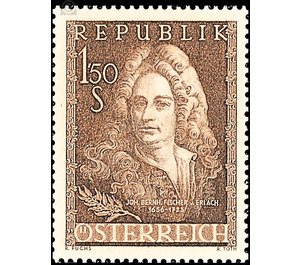300th birthday - Austria / II. Republic of Austria 1956 - 1.50 Shilling
Theme: Well-known people
| Country | Austria / II. Republic of Austria |
| Issue Date | 1956 |
| Face Value | 1.50 |
| Color | brown |
| Printing Type | Typography |
| Stamp Type | Commemorative |
| Item Type | Stamp |
| Chronological Issue Number | 371 |
| Chronological Chapter | OOS-OE2 |
| SID | 135632 |
| In 45 Wishlists | |
Johann Bernhard Fischer von Erlach was born on July 20, 1656 in Graz. He studied antiquities in Italy and learned to appreciate the ancient world. The extension of the castle in Frain by the towering construction of the ancestral hall was probably Fischer's first work in the territory of the Austrian monarchy. Fischer was appointed in 1687 as a teacher of civil architecture for the then nine-year Crown Prince Joseph. When in 1690 his pupil Crown Prince Joseph was crowned Roman Emperor, he was commissioned to erect a triumphal arch for his entry into Vienna. As a result, monumental works of this gifted architect were created, which astonish the viewer even today. In Salzburg, four churches were built whose execution overlapped in time. The Church of the Holy Trinity (1694 to 1702), the Kollegienkirche (1696 to 1707), the Ursuline Church (1699 to 1705) and the Johannesspitalkirche (1699 to 1704) have a two-storey façade, structured by a colossal order of pilasters. In Salzburg, he created only the later heavily modified Schloss Kleßheim and the much admired high altar in the Franciscan church in Salzburg. Schönbrunn Palace was begun in 1686 to build according to his designs. When the plague broke out in Vienna in 1713, Emperor Charles VI vowed to build a church dedicated to St. Charles Borromeo. In the competition Fischer emerged victorious alongside Hildebrandt and Ferdinando Galli-Bibiena. Fischer did not live to see the completion of the building. He died on 5 April 1723. It was not until two years after his death that the dome was closed and twelve years later the Karlskirche was completed.


